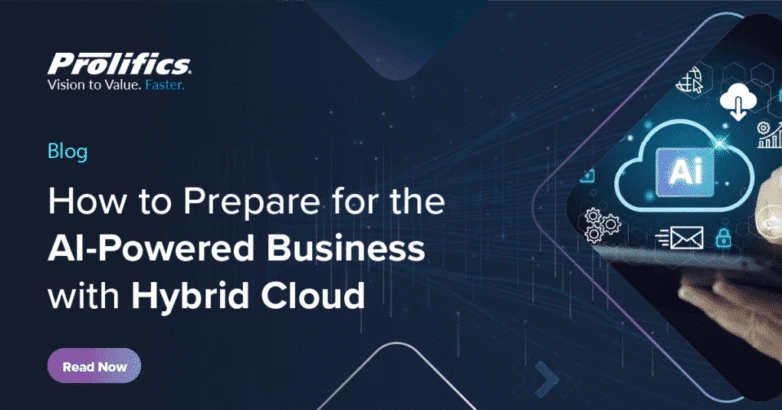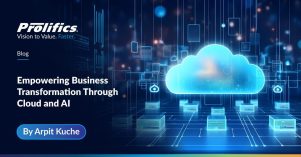Artificial Intelligence (AI) is reshaping the very fabric of modern business. From revolutionizing customer service to accelerating code modernization and automating workflows, AI-powered business with hybrid cloud—particularly generative AI—is unlocking new levels of productivity and innovation. But the true power of AI can only be harnessed when it is paired with the right infrastructure: a hybrid cloud strategy and a trusted technology architecture.
In this blog, we explore valuable insights from industry leaders to help you prepare for an AI-powered business with hybrid cloud. We’ll look at how organizations are adopting generative AI in business across key functions and why a hybrid cloud strategy is essential to scaling these capabilities confidently.
Generative AI: Redefining Possibilities in Business
Generative AI in business, including GPT and diffusion models, enables businesses to automate and create like never before. According to recent reports Spending on artificial intelligence (AI) in India is expected to grow at a compound annual growth rate of 31.5 per cent from 2023 and might reach $5.1 billion by 2027, according to a joint study released on Tuesday by Intel and International Data Corporation (IDC)., especially in high-impact areas such as:
1. Customer Service Transformation
AI-powered chatbots and virtual assistants are no longer just nice-to-haves. They’re becoming central to customer engagement strategies. Generative AI in business allows these assistants to understand context, sentiment, and intent—creating natural, human-like conversations. By automating common queries, guiding users through complex processes, and even predicting customer needs, AI can free up human agents to focus on higher-value tasks.
Insight: Leading companies are combining Generative AI in business with customer data to create hyper-personalised support experiences that drive satisfaction and loyalty. For example, by leveraging hybrid cloud strategy, organizations can securely access customer data wherever it resides, ensuring consistent and intelligent service delivery across all channels.
2. Code Modernisation and Developer Productivity
Generative AI in business is also helping developers by writing, debugging, and refactoring code. With tools like GitHub Copilot and IBM watsonx Code Assistant, businesses are significantly reducing development cycles and improving code quality.
Insight: Enterprises are integrating AI and cloud integration in business into DevOps pipelines, allowing for faster innovation without compromising security or governance. hybrid cloud strategy, enable this by supporting legacy systems while providing access to modern cloud-native environments, enabling a seamless transition toward modern architecture.
3. Workflow Automation for Operational Excellence
Routine business processes—from document processing to supply chain coordination—can now be fully automated using AI. AI-powered automation enhances this by interpreting unstructured data, generating summaries, and making intelligent decisions in real-time.
Insight: Businesses that adopt AI-powered automation for workflow automation report faster cycle times and reduced operational costs. With a hybrid cloud strategy, these automation solutions can be deployed consistently across on-prem and cloud environments, ensuring scalability and compliance in highly regulated industries.
Why Hybrid Cloud is Key to Scaling AI
While AI-powered automation provides the engine for transformation, the AI and cloud integration acts as the highway—allowing you to deliver these capabilities at scale, with flexibility, security, and control.
1. Data Gravity and Sovereignty
AI models thrive on data. But for many organisations, data is fragmented across environments. A hybrid-by-design cloud architecture allows you to keep sensitive data on-premises while using public cloud resources for AI training and inference—ensuring compliance with local regulations and reducing data movement costs.
Industry Insight: Financial institutions and healthcare providers are adopting this approach to ensure data sovereignty while still reaping the benefits of AI and cloud integration.
2. Optimised Resource Allocation
AI workloads require enormous computational power. AI and cloud integration lets you elastically scale infrastructure based on demand. You can train models on high-performance GPU clusters in the public cloud while running inference at the edge or on-prem, close to where data is generated.
3. Built-in Security and Trust
AI introduces new risks—bias, hallucinations, data leakage. A trusted hybrid cloud strategy embeds security, compliance, and governance into every layer. Platforms like IBM’s watsonx, combined with Red Hat OpenShift, allow organizations to manage and monitor AI models across environments, ensuring responsible and ethical AI usage.
[/et_pb_text][/et_pb_column][/et_pb_row][et_pb_row _builder_version=”4.27.4″ _module_preset=”default” global_colors_info=”{}”][et_pb_column type=”4_4″ _builder_version=”4.27.4″ _module_preset=”default” global_colors_info=”{}”][et_pb_text _builder_version=”4.27.4″ _module_preset=”default” global_colors_info=”{}”]
Building the Right Foundation for AI
To prepare for the AI-powered business with hybrid cloud, consider the following steps:
1. Establish a Clear AI Strategy
Align your AI initiatives with business goals. Start with high-impact use cases like customer support, code automation, and process optimization. Build cross-functional teams to ensure alignment between IT, data science, and business stakeholders.
2. Invest in a Hybrid Cloud Platform
Select a hybrid cloud strategy that provides flexibility to run workloads across multiple environments. Look for solutions that offer containerization, orchestration, and support for open standards to ensure portability and interoperability.
3. Modernise Your Data Architecture
AI is only as good as the data it learns from. Invest in data integration, governance, and quality tools. Use data fabric or data mesh approaches to make data discoverable, accessible, and trustworthy across your AI and cloud integration.
4. Prioritise Trust and Governance
Ensure that your AI systems are transparent, explainable, and accountable. Implement guardrails using AI governance frameworks to monitor model performance, detect bias, and manage risk across the lifecycle.
Looking Ahead: AI and Hybrid Cloud as the Innovation Engine
The convergence of AI-powered automation and hybrid cloud strategy is ushering in a new era of intelligent enterprise. It’s enabling organizations to innovate faster, serve customers better, and optimize operations at scale. But to harness its full potential, businesses must build the right foundation—starting with a hybrid-by-design infrastructure and a trusted technology stack.
Whether you’re modernizing legacy systems, automating workflows, or delivering next-gen customer experiences, the path to success lies in a hybrid cloud strategy that brings AI and cloud integration closer to your data, your people, and your business goals.




